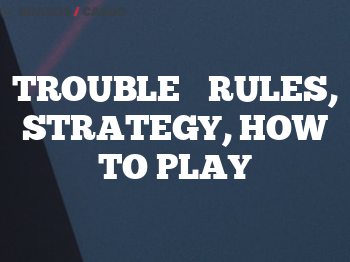Trouble: The Classic Board Game of Strategy and Chance
Introduction
I have enjoyed countless games of Trouble over the years (known as Frustration in the UK and Kimble in Finland). It’s an easy game, with simple rules, that encourages a little bit of competition and friendly frustration. Trouble is a classic board game that has been enjoyed by other families across the world for generations. It is a game of strategy and chance, where players move their pieces around the board, trying to get all of their pieces home before their opponents. The game was first introduced in the United States by the Kohner Brothers in 1965 and has since become a staple in many households.

The game is played on a board with a pop-o-matic dice roller (always a fan favorite) in the center. Each player has four pieces of their color that they move around the board. The goal of the game is to be the first player to get all four of their pieces into their home spaces. The game is simple to learn, but can be challenging to win, making it a great game for players of all ages.
Quick Tip
One quick tip for winning at Trouble is to always keep an eye on your opponents’ pieces. If you see an opportunity to send an opponent’s piece back to the start, take it. This can slow down your opponents and give you an advantage.
Rules for Playing Trouble
- Each player chooses a set of four pieces of the same color and places them in their matching color home base.
- Players take turns pressing the pop-o-matic dice roller and moving their pieces around the board. The number rolled determines how many spaces a player can move one of their pieces.
- If a player rolls a 6, they can either move a piece out of their home base onto the start space, or move a piece already on the board six spaces. After rolling a 6, the player gets another turn.
- If a player’s piece lands on a space occupied by an opponent’s piece, the opponent’s piece is sent back to their home base.
- The first player to get all four of their pieces into their home spaces wins the game.
These are the official rules for Trouble, but many people play with their own house rules. For example, some people play that a player must roll a 6 to move a piece out of their home base, while others allow any roll to move a piece out.
How to Play Trouble
Trouble is an easy game to play for kids ages 5 and up. Start by having each player selecting a peg color. For instance, blue, then place the blue peg on the blue starting space. Activate the pop-o-matic dice roller by giving it a push. If you get a 4, that means you can move your peg 4 spots. For kids, it’s good to count out the spaces as you move: 1, 2, 3, 4. Then it’s the next player’s turn to pop the dice and move.
Setup
At the start of the game, each player chooses a peg color and places their four pieces in their matching color home base. The youngest player goes first.
Gameplay
Players take turns pressing the pop-o-matic dice roller and moving their pieces around the board. The number rolled determines how many spaces a player can move one of their pieces toward the center. If a player’s piece lands on a space occupied by an opponent’s piece, the opponent’s piece is sent back to their home base.
End of the Game
The game ends when one player gets all four of their pieces into their home spaces. That player is the winner of the game.
The official Autism-friendly instruction booklet for Trouble is available here, in PDF
How to Win at Trouble
Winning at Trouble requires a combination of strategy and luck, plus a bit of persistence. Here are some strategies that can help you win:
- Try to get all of your pieces out of your home base as quickly as possible. This gives you more options for movement and makes it harder for your opponents to send your pieces back to the start.
- Always be aware of your opponents’ pieces. If you see an opportunity to send an opponent’s piece back to the start, take it. This can slow down your opponents and give you an advantage.
- Try to spread out your pieces on the board. This makes it harder for your opponents to send your pieces back to the start and gives you more options for movement.
- Remember that the game is not over until one player gets all of their pieces into their home spaces. Even if you are behind, keep playing and try to make the best moves possible. You never know when luck will turn in your favor.
Best Strategies for Playing Trouble
While Trouble is a game of chance, there are still strategies that can increase your chances of winning. Here are some of the best strategies for playing Trouble:
- Spreading out your pieces on the board reduces the changes of your opponents sending your pieces back to the start and gives you more options for movement.
- Try to get your pieces out of your home base as quickly as possible. The more pieces you have on the board, the more options you have for movement.
- If you can send an opponent’s piece back to the start, do it. Slowing down your opponents is often more valuable (and more fun, of course) than advancing your own pieces.
- Don’t give up if you are behind. The game is not over until one player gets all of their pieces into their home spaces. Keep playing and try to make the best moves possible.
Scenarios for Trouble
There are many different scenarios that can occur in a game of Trouble. Here are some common scenarios and how to handle them:
- If you have a piece that is close to your home spaces and you roll a number that is too high to move that piece into your home spaces, consider moving a different piece instead. This can help you avoid getting stuck and allow you to continue moving your pieces around the board.
- If an opponent has a piece that is close to their home spaces, try to send that piece back to the start if you can. This can slow down your opponent and give you an advantage.
- If you have multiple pieces on the board and you roll a 6, consider moving a piece that is further away from your home spaces. This can help you spread out your pieces and make it harder for your opponents to send your pieces back to the start.
- If you are behind and it seems like one of your opponents is about to win, don’t give up. Keep playing and try to make the best moves possible. You never know when luck will turn in your favor.
Frequently Asked Questions about Playing Trouble
- What happens if I roll a number that is too high to move a piece into my home spaces?
If you roll a number that is too high to move a piece into your home spaces, you cannot move that piece. You can either move a different piece or lose your turn. - Can I move a piece out of my home base if I roll a number other than 6?
According to the official rules, you can move a piece out of your home base if you roll any number. However, some people play with a house rule that you must roll a 6 to move a piece out of your home base. - What happens if I land on a space occupied by my own piece?
If you land on a space occupied by your own piece, nothing happens. You cannot send your own pieces back to the start. - Can I move my pieces backwards?
No, you cannot move your pieces backwards. Pieces must always move forward around the board. - What happens if I roll a 6?
If you roll a 6, you can either move a piece out of your home base onto the start space, or move a piece already on the board six spaces. After rolling a 6, you get another turn.
External Links
Official Homepage of Trouble by Hasbro

Eve Brownlee was a gamer before gaming communities on the internet were a thing. Eve grew up playing traditional, standard deck card games like Rummy and Bezique, taking an interest in the classics Backgammon and Chess. Parlor card games like Bridge continue to keep Eve active in the community. After a long career, primarily in horticulture for USDA in Maryland, Eve now travels and writes on The Pineapple (pineapples.info) and contributes to Quora/Pinterest topics. Contact Eve via email.



